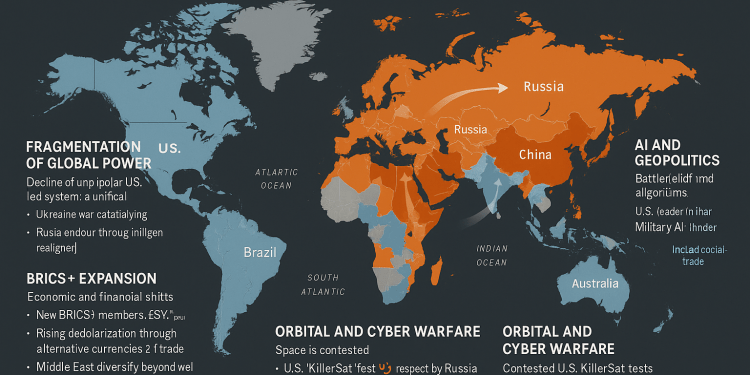🌍 Introduction
The notion of a stable, U.S.-led global order is no longer viable in 2025. Over the past five years, a confluence of factors — including the Ukraine war, COVID-19’s economic aftershocks, the weaponization of technology, and the rise of alternative alliances — has accelerated a systemic transformation of global power.
According to a 2023 RAND Corporation report, “strategic competition is no longer limited to military capacity but includes digital infrastructure, narrative dominance, and economic sovereignty.”
🧭 1. The Decline of the Unipolar Order
For nearly three decades after the Cold War, the world operated under a unipolar system, centered around U.S. economic, military, and institutional leadership.
However, data from the International Monetary Fund (IMF, 2024) reveals a shift:
- In 2000, the G7 economies accounted for 65% of global GDP
- In 2025, that figure has dropped below 43%, with BRICS+ now making up 32%
Meanwhile, U.S. military dominance is challenged by:
- China’s AI-enhanced military planning (source: SIPRI 2024)
- Russia’s increased nuclear warhead readiness (source: IISS Military Balance 2025)
⚔️ 2. The War in Ukraine: More Than a Battlefield
The Ukraine conflict continues to define 21st-century hybrid warfare.
According to the U.K. Ministry of Defence (2025 update), Russia has suffered an estimated 315,000 casualties, but maintains frontline presence and drone warfare capacity.
Western aid to Ukraine:
- $113 billion from the U.S. (Congressional Budget Office, March 2025)
- €84 billion from EU (European Commission, Q1 2025)
Yet, a 2025 Pew Research global survey reveals:
“Over 48% of respondents in 12 NATO countries are unsure whether continued aid to Ukraine is sustainable.”
The war has also intensified energy reconfiguration:
- LNG imports from the U.S. to Europe have tripled since 2021
- Russian oil exports to China and India reached historic highs in late 2024 (source: Reuters)
🧠 3. Artificial Intelligence and the New Face of Power
Geopolitical dominance in 2025 hinges not only on weapons, but on who controls algorithms.
According to the OECD Global AI Watch Report (2025):
- China leads in government-deployed facial recognition
- The U.S. leads in defensive AI (e.g. autonomous drone targeting)
- Europe lags behind, focusing more on regulatory frameworks (AI Act 2024)
Military application:
- DARPA’s “Mosaic Warfare” strategy uses distributed AI decision nodes
- PLA’s “GhostNet” platform integrates battlefield AI and social sentiment mapping (Source: Chinese Defense White Paper 2024)
AI is also disrupting diplomacy — GPT-class models are now used to simulate foreign policy decisions, and NATO’s 2025 summit included an AI-driven war game on Baltic defense.
💰 4. BRICS+ and the De-Dollarization Momentum
With the 2024 expansion (including Egypt, Iran, UAE, Argentina), BRICS+ now represents over 45% of the world’s population and 28% of GDP.
Key developments:
- The BRICS Development Bank issued its first non-USD-denominated energy loan in 2025 to Kenya
- Cross-border trade deals between China and Saudi Arabia now settled in yuan
- Iran, India, and Russia have tested a blockchain-based alternative to SWIFT
Even the BIS (Bank for International Settlements) noted in January 2025 that:
“Global trade settlement in alternative currencies has reached 22%, up from 13% in 2021.”
While the dollar remains dominant, its monopoly is eroding — not overnight, but systemically.
🕊 5. Middle East Realignment: Strategic Decoupling from the West
The region once defined by U.S. hegemony is now diversifying.
Facts:
- In 2024, Iran and Saudi Arabia restored diplomatic relations, mediated by China
- The Abraham Accords have not collapsed, but normalization efforts are stalling
- U.S. CENTCOM reports reduced troop presence in Iraq and Syria, reallocating to Pacific command
Meanwhile:
- China signed long-term oil security agreements with both Tehran and Riyadh
- Russia has become a top arms supplier to Algeria and Egypt (source: SIPRI 2025)
In essence, the Middle East is multi-pivoted, balancing ties between BRICS+, the West, and regional powers.
🛰 6. Orbital Infrastructure and Cyber Sovereignty
2025 is the year space officially becomes a contested domain.
- The U.S. has deployed 470+ military-grade satellites under Space Force command
- China’s Tiangong Station operates with defense-integrated research
- Russia has tested a “KillerSat” prototype in low-earth orbit (UN Security Council meeting, March 2025)
Simultaneously, digital sovereignty is a priority:
- India launched its own DNS firewall
- The EU’s Gaia-X infrastructure challenges U.S. cloud monopoly
- Over 30 countries have adopted national firewalls or content-control systems
📍 Conclusion: This Is the Reset, Not the Rehearsal
What we witness in 2025 is not a theoretical shift — it is an ongoing fragmentation and reordering of the international system.
Power is:
- No longer linear
- No longer only military
- And no longer monopolized
The new world order is algorithmic, multipolar, economically bifurcated, and increasingly post-Western.




